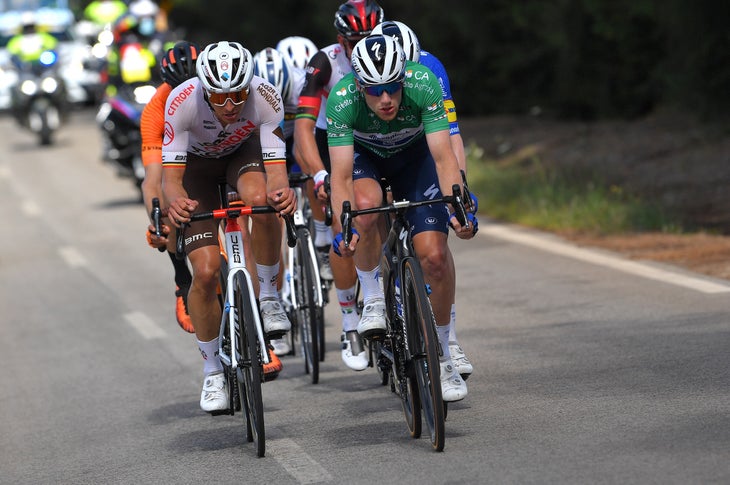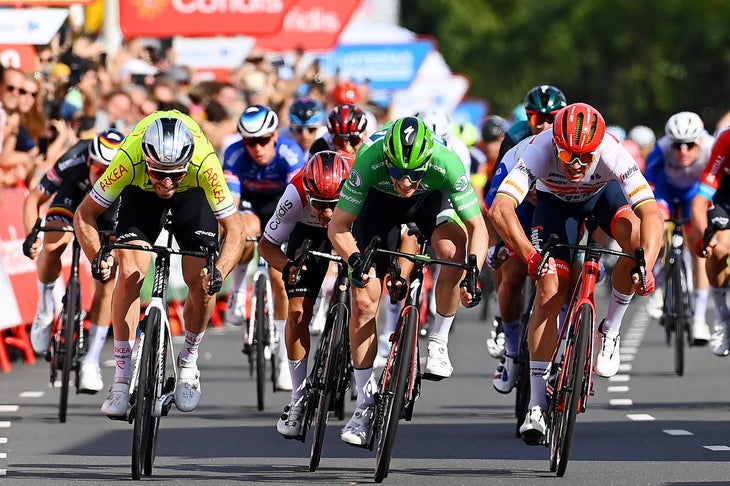Heading out the door? Read this article on the new Outside+ app available now on iOS devices for members! Download the app.
Forget about the debate over brown shorts. There are a host of bigger factors facing a rider when they change teams. For Sam Bennett, switching from Bora-Hansgrohe to Decathlon-Ag2r La Mondiale has brought with it a variety of imposed modifications.
New bike. New equipment. New teammates. New support staff. And with that, a new coach.
Changing trainers is a complicated process. It takes time for a rider to get to know a coach, and for a coach to get to know a rider.
It’s about personalities, and building a relationship, but it’s also about knowing a rider and understanding what makes them tick.
What are their strengths? What are their weaknesses? How do you maximise the first, and minimise the second?
What training and racing tweaks need to be made to ensure that the best possible outcome is achieved?
Fortunately that process had a little bit of a head start.
Also read:
Decathlon Ag2r La Mondiale coach Stephen Barrett first met Bennett years ago. They grew up in towns just over an hour apart, rode some of the same amateur races, and are part of the same relatively small cycling scene in Ireland.
Now a fleeting acquaintance is becoming a much deeper one, with an athlete-coach relationship developing week by week.
“I’m excited to work with Sam,” Barrett told Velo recently. “I know what he did in 2020. We all do. The last time he rode the Tour de France he won the green jersey. For me, it’s the first time I’m going to coach a WorldTour Irish rider and that gives me a lot of motivation to really do the maximum we can to make sure he can win some races.”
Fortunately Barrett has a good track record. He has worked with several English-speaking riders on the Ag2r team and through them secured Tour de France stage victories in 2021, 2022 and 2023.
That’s an impressive run, and one he wants to continue.
“With Ben O’Connor, Bob Jungels, and Felix Gall, I’m three for three with Tour stage wins,” he told Velo recently. “And Sam is my next target for 2024.”

The road back to the top: Looking for the little clues
It’s early days yet in their collaboration, but Bennett told Velo recently that he’s feeling encouraged by what they have identified together thus far.
“I’ve had three frustrating years. I needed a fresh start,” he explained. “I never got up and running, really. I had good moments, actually. At the end of 2022 I thought I was back. But I had a few hiccups and I was gone again.
“But we were looking back in the files and we could see little clues about where to improve. Little things that show us that it’s still there, and show what is needed to be done.”
Bennett certainly needed to press a reset button. He was arguably the world’s best sprinter in 2020 and the first months of 2021, winning two stages plus the green jersey in the Tour de France and clocking up multiple successes elsewhere.
That run off success was interrupted by a knee injury in May 2021 and since then his results have faltered. He did take two stage wins in the 2022 Vuelta a España, but then had to leave the race with Covid. He hasn’t ridden the Tour de France in the past three years.
As he said, a fresh start was needed. He’s hoping to find that at Decathlon Ag2r La Mondiale.
Nouveau coureur / New rider
Bienvenue @Sammmy_Be
♂️ @Sammmy_Be
✍️ 2️⃣0️⃣2️⃣5️⃣#DECATHLONAG2RLAMONDIALETEAM pic.twitter.com/n0YGidOLuV— AG2R CITROËN TEAM (@AG2RCITROENTEAM) November 27, 2023
Barrett has spent considerable time talking to Bennett and poring over his training and racing data, and has identified areas to work on.
“It’s been interesting,” he told Velo. “I’ve not coached a top class sprinter in the past, but I certainly have an eye for data. For me, the biggest thing that I look at is the demands of racing. And the demands of racing have changed quite a bit in the last five, six years.
“If you’re a climber, we know what you need to do in terms of watts per kilo. We know you need to be very, very good on the descents. We know you need to be extremely good in the time trial.
“I think now as well for sprinting, you need to be able to adapt to certain situations. There’s less reliance on the big leadout trains, for one.
“With Sam, when you go back and look at historical data, he doesn’t have the biggest threshold. So I think first of all, the biggest thing we can do is to increase his threshold. That in turn will increase his overall resilience, his durability, his fatigue resistance.
“If we can get Sam to the last 500 meters having expended the least amount of energy, then he should be able to apply his most power.”
So, goal one: build his aerobic fitness, and ensure that he gets to the final kilometre fresher than in recent years.
And goal two?
According to Barrett, that’s all about building his power with specific sessions.
“What Sam hasn’t really done a lot of in the last few years is high torque work,” he said. “We know power is the king of what makes us go fast, but power is a combination of torque, or how strong you are, and velocity, how fast you move. So that depends on his cadence and his ability to apply torque.
“And Sam hasn’t done a whole pile of torque work in the previous years. So that’s something we will start to expand a bit, where we can give Sam an ability to be able to apply more torque to the to the pedals, which then will allow him then to inevitably go faster.
“That was a big one, and we’ve started work on that. But the fatigue resistance is the biggest. It’s about how can we get him to get through a stage and be the most efficient possible. That can be achieved through good training, consistent training.”
Barrett is indeed correct. When Bennett was at his best, he was outclimbing most if not all of the other sprinters in the peloton. He’s lighter than many of them, and there are many past examples of races where he has stayed in contention while his rivals have been left far behind.
He’s also taken uphill stage wins in races such as the Presidential Tour of Turkey, on occasion jumping away from the rest of the field with a kilometre or more to go.
Those qualities are part of his physiological makeup; it’s just a case of unlocking them once again.

“His threshold was up around where he’s has his best numbers in the past.”
Bennett and Barrett first spoke to Velo about their collaboration several weeks ago. Since then they have spent a solid amount of time together, with a recent stay in Lille seeing him work closely to get his equipment and bike position perfected.
Over a period of seven days bike sponsor Van Rysel and others helped Bennett adjust to a new machine, new pedals, a new saddle and different shoes.
He then spent a week or so in Ireland, training hard, before heading to Gandia in Spain for a fortnight.
The hard work continued there, with the team camp ending a lot better than it started.
“It took a took a few rides for Sam to get into the rhythm of things,” Barrett revealed. “The first two days were a bit difficult. It took him a day or two to realise his fitness was actually not in a bad place, and also it also took a day or two for his own confidence to come back.”
The team organised the training around two blocks of four days. The second block was where he really started to get into his stride.
“We did a lactate test then. I think this was the first point where you could see Sam’s confidence change. He realized actually how fit he is. I think that confidence is something that Sam didn’t have.
“He had a couple of barren years with Bora, he came to the camp a little bit apprehensive of how he was. He just didn’t know. We did a lactate test in the first day of the second block. He showed levels then…his threshold was up around where he’s has his best numbers in the past.”
According to Barrett, that test gave Bennett confidence that the work he has been doing over the past three to four weeks has really paid off.
Towards the end of the camp the squad did a full-on team time trial and some sprint leadouts.
“You could see Sam gain conference and build into himself every day,” Barrett explained. “He really became a leader in that second part of the training camp.”
Next up is a few days off over Christmas break, then he’ll knuckle down again. In early January he will return to Spain for another team training camp, with his 2024 race debut set for a French event in the first week of February.
His program will likely see him race in the Middle East prior to a block of competition back in Europe.
The goal is to build steadily, to do some harder races during the season rather than just target the flatter, easier events. Short term that could reduce the win tally; longer term, he should become a stronger rider as a result.
For Barrett, perhaps the most important and encouraging thing is Bennett’s hunger to succeed.
“Over the past year or two he didn’t achieve what he felt he could achieve. I think there’s that misconception that maybe he’s past it,” he said. “That there’s some better, younger, faster guys. But knowing Sam, and also from speaking to him now, I have no sense that he’s here to take the easy way out.’
“As I heard from day one, he wants to win the green jersey. He wants win the points in the Vuelta. He wants to win the points jersey in the Giro.
“He has all these big ambitions still, because he knows he’s capable of doing that.”
"fit" - Google News
December 25, 2023 at 09:47PM
https://ift.tt/ou4Gc17
Sam Bennett Building Solidly Again: 'He Realized How Fit He Is' - Outside Magazine
"fit" - Google News
https://ift.tt/fNxtW5n
https://ift.tt/uI386iZ
Bagikan Berita Ini














0 Response to "Sam Bennett Building Solidly Again: 'He Realized How Fit He Is' - Outside Magazine"
Post a Comment